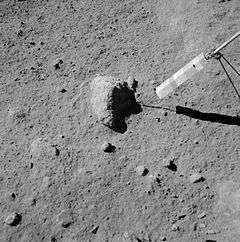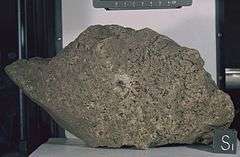Great Scott (lunar sample)



Lunar Sample 15555, better known as "Great Scott", is a lunar sample discovered and collected on the Apollo 15 mission in 1971 in the Hadley-Apennine region of the moon. The rock is a 9.614 kg (21.20 lb) olivine-normative basalt. It is named after mission commander, David Scott, and it is the largest sample returned to earth from the mission, as well as the most intensively studied.[1] It was collected by Scott on the rim of Hadley Rille, at station 9A.
Great Scott is currently stored at the Lunar Sample Laboratory Facility at the Lyndon B. Johnson Space Center. A piece of it is on display at the National Museum of Natural History in Washington, DC. Another is on display at the Franklin Institute in Philadelphia, Pennsylvania.
Description
Lunar sample 15555 is a coarse-grained, porphryritic rock with rounded olivine phenocrysts (1 mm) and subhedral zoned pyroxene phenocrysts (0.5-2 mm) set in a matrix of poikilitic plagioclase (up to 3 mm).[2]
References
- ↑ Apollo 15 Lunar Sample Atlas at L&PI
- ↑ Sample 15555 summary sheet at L&PI